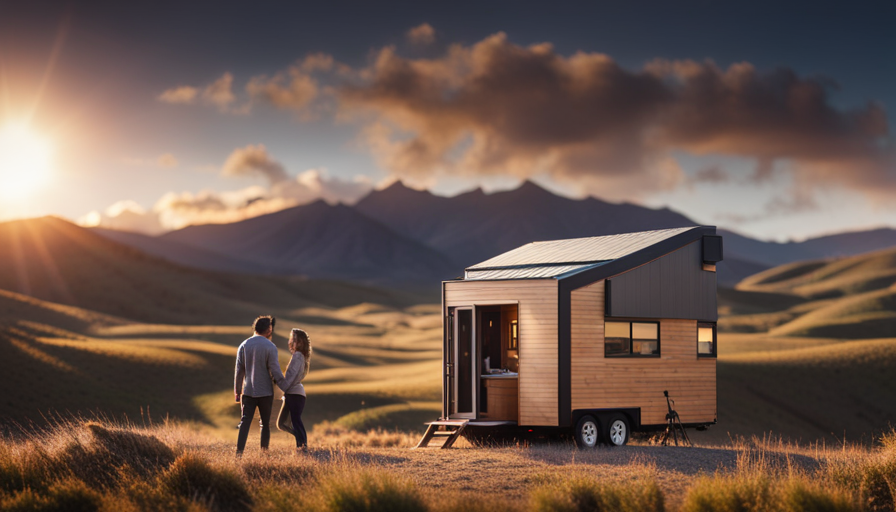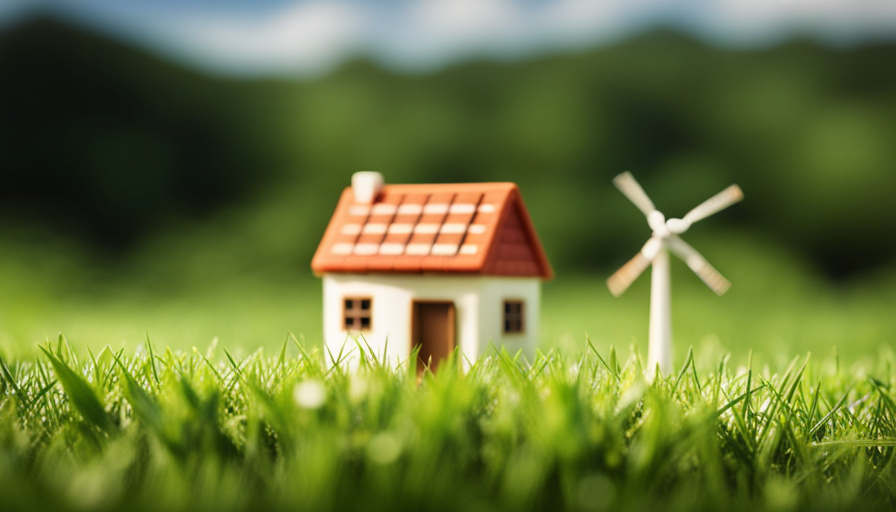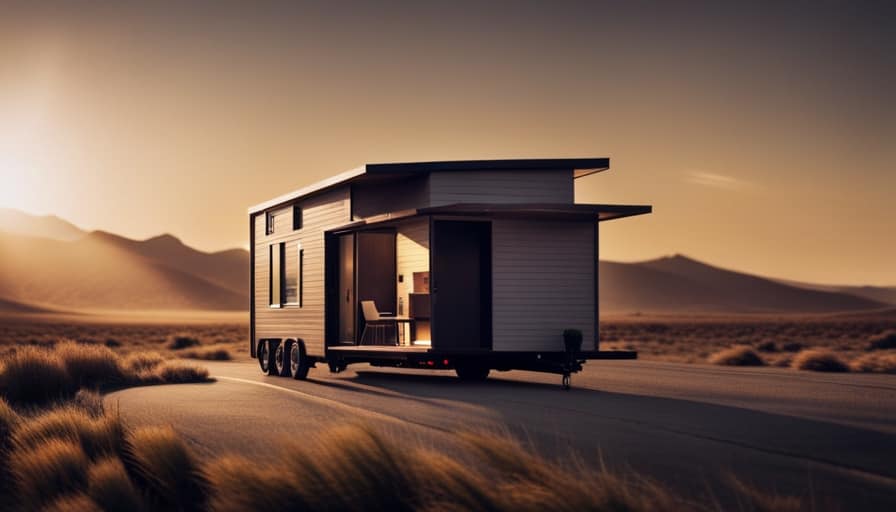Have you ever felt a strong desire to simplify your life, declutter your belongings, and embrace a more minimalist lifestyle? If so, you’re not alone. There has been a growing trend towards living in tiny houses – small, practical homes that prioritize functionality and sustainability.
Welcome to the world of the Tiny House Movement.
The Tiny House Movement has taken the world by storm, captivating the hearts and minds of individuals seeking a simpler way of life. From its humble beginnings in the early 2000s, this movement has gained momentum and popularity, with people from all walks of life embracing the idea of living in spaces as small as 100 square feet.
In this article, we will explore the origins of the Tiny House Movement, delve into its key principles, and discuss the different types of tiny homes available. We will also examine the benefits and challenges of living in a tiny house, share success stories of tiny house dwellers, and provide resources and support for those interested in joining this movement.
So, let’s dive in and discover just how big the Tiny House Movement truly is.
Origins of the Tiny House Movement
The origins of the tiny house movement can be traced back to the early 2000s when people started embracing the idea of living in compact and portable homes. With the rising costs of housing and the desire for a simpler and more sustainable lifestyle, individuals began to seek alternatives to traditional homes.
The concept of living in a smaller space gained traction, and people started to build and live in tiny houses as a way to reduce their environmental impact and financial burdens. The tiny house movement has experienced significant growth over the years. What initially started as a niche trend has now become a global phenomenon.
People from various backgrounds and walks of life are choosing to downsize and live in tiny homes. This growing interest can be attributed to several factors, including the desire for financial freedom, the need for a more minimalist lifestyle, and the increasing awareness of environmental issues.
Transition: Understanding the origins and growth of the tiny house movement is crucial to exploring its key principles.
Key Principles of the Tiny House Movement
When it comes to the key principles of the Tiny House Movement, two important aspects that stand out are downsizing and decluttering, as well as sustainability and environmental consciousness.
Downsizing and decluttering is a fundamental aspect of the movement, as it encourages individuals to live with only what they truly need and eliminate unnecessary possessions. This not only allows for a simpler and more organized lifestyle, but also helps reduce the environmental impact by consuming fewer resources.
Additionally, sustainability and environmental consciousness play a significant role in the movement, with many tiny house builders and dwellers focusing on using eco-friendly materials, incorporating renewable energy sources, and adopting sustainable practices in their daily lives.
Downsizing and decluttering
After shedding unnecessary possessions, it’s like a weight off your shoulders when you finally embrace downsizing and decluttering in the tiny house movement. The minimalist lifestyle that accompanies tiny living encourages individuals to prioritize what truly matters and let go of excess belongings.
To make the most of limited space, space-saving techniques become essential. Furniture with multiple functions, such as a sofa that can transform into a bed or a dining table that doubles as a workspace, are popular choices in tiny houses. Additionally, organizers and storage solutions are utilized to maximize every inch of available space.
Adopting these practices not only creates a more efficient living environment but also promotes a sense of freedom and mental clarity. Transitioning into the subsequent section on sustainability and environmental consciousness, the principles of downsizing and decluttering align with the overall goal of reducing our ecological footprint and living more intentionally.
Sustainability and environmental consciousness
Embrace sustainability and environmental consciousness by making conscious choices to reduce your ecological footprint and live more intentionally. The tiny house movement is closely associated with green building practices and off-grid living. Many tiny homes are built using eco-friendly materials, such as reclaimed wood, recycled metal, and sustainable insulation. These homes are designed to be energy-efficient, with features like solar panels, rainwater collection systems, and composting toilets.
Living off the grid allows individuals to rely less on traditional utilities and instead harness renewable resources. By embracing these sustainable practices, tiny house dwellers can significantly reduce their impact on the environment while still enjoying a comfortable and functional living space.
Transitioning into the subsequent section about different types of tiny homes, it’s important to explore the various designs and layouts that cater to individual preferences and needs.
Different Types of Tiny Homes
There are various types of tiny homes that cater to different preferences and lifestyles. These innovative designs have sparked a revolution in the housing industry, offering a unique and sustainable way of living.
Here are three popular types of tiny homes:
-
Tiny Houses on Wheels (THOWs): These mobile homes are built on trailers, allowing homeowners to easily transport them to different locations. They often feature clever space-saving solutions like lofted bedrooms and multipurpose furniture.
-
Shipping Container Homes: Repurposing shipping containers into living spaces has gained popularity due to their durability and affordability. These compact homes can be stacked or combined to create larger living areas, making them suitable for individuals or families.
-
Earthship Homes: These off-grid dwellings are made from natural and recycled materials, such as tires, bottles, and earth. They are designed to be self-sustaining, utilizing solar power, rainwater harvesting, and natural ventilation systems.
Each type of tiny home offers its own unique benefits and design elements, making it easier for individuals to find a style that suits their needs.
Transitioning into the subsequent section about the benefits of living in a tiny house, it becomes clear that these innovative dwellings not only provide a smaller footprint but also offer a more sustainable and affordable way of life.
Benefits of Living in a Tiny House
One of the greatest advantages of residing in a compact dwelling is the freedom it provides to live a more minimalist and sustainable lifestyle. A tiny house encourages us to let go of excessive material possessions and focus on what truly matters. With limited space, we’re forced to declutter and prioritize our belongings, leading to a simpler and more organized living environment.
Not only does this promote a sense of calm and tranquility, but it also reduces the time and energy spent on cleaning and maintenance.
Living in a tiny house also brings financial freedom. The cost of purchasing or building a tiny home is significantly lower compared to traditional houses. Additionally, the reduced utility bills and maintenance expenses further contribute to financial savings. With less money tied up in housing expenses, individuals have the opportunity to allocate their resources towards other important aspects of life, such as travel, education, or pursuing their passions.
Transitioning into the subsequent section about challenges and considerations of tiny house living, it’s important to acknowledge that although there are many benefits, there are also practical challenges that come with living in a tiny house.
Challenges and Considerations of Tiny House Living
Living in a tiny house presents several challenges and considerations that need to be taken into account. Firstly, limited space and storage can be a major issue, requiring creative solutions and efficient organization.
Secondly, zoning and legal issues can arise when it comes to finding a suitable location to park or build a tiny house, as regulations can vary greatly.
Lastly, there may be social stigma and a lack of community acceptance towards tiny house living, which can impact the overall experience and sense of belonging.
Limited space and storage
Despite limited space and storage, the tiny house movement offers clever solutions to maximize living areas and keep belongings organized. In tiny houses, every inch counts, so homeowners have to get creative with their storage options.
From built-in cabinets and shelves to hidden compartments and multi-purpose furniture, there are countless ways to make the most of the available space. Vertical storage is also a popular choice, with hooks, shelves, and hanging organizers utilized to utilize wall space. Additionally, furniture with hidden storage compartments, such as ottomans or beds with drawers underneath, can help maximize storage without sacrificing aesthetics.
These innovative solutions allow tiny house dwellers to live comfortably and efficiently in their small homes.
Now, let’s explore the challenges and considerations of zoning and legal issues within the tiny house movement.
Zoning and legal issues
Limited space and storage are not the only challenges faced by those living in tiny houses. Another significant obstacle is zoning and legal issues.
Zoning regulations vary from place to place, and many areas have not yet adapted their laws to accommodate tiny houses. Some jurisdictions have minimum size requirements for dwellings, which can make it difficult for tiny house enthusiasts to find a suitable location. Additionally, there may be restrictions on where tiny houses can be parked or placed, limiting the options for those wanting to live in these compact homes.
Legal restrictions can also arise when it comes to utilities, such as water and electricity connections. These obstacles can make it challenging for individuals to join the tiny house movement and find a place to call home. However, despite these challenges, the tiny house movement continues to grow as individuals seek alternatives to traditional housing options.
Social stigma and community acceptance
Although many people are attracted to the idea of living in a small space, the social stigma surrounding tiny houses can often create challenges for those seeking community acceptance.
While some individuals view tiny houses as a unique and sustainable housing option, others may see them as a symbol of poverty or an eyesore in their neighborhoods. This social impact can make it difficult for tiny house enthusiasts to find acceptance within their communities.
Additionally, affordability challenges can further exacerbate this issue. The cost of land, permits, and infrastructure can make it difficult for individuals to find suitable locations for their tiny homes. These challenges can hinder the growth of the tiny house movement and limit its social impact.
However, despite these hurdles, the tiny house movement continues to gain momentum and make a positive impact on housing options.
Impact of the Tiny House Movement
The impact of the Tiny House Movement can be seen in various aspects of our society. Firstly, it has influenced the housing industry by challenging traditional notions of what a home should be, leading to a greater focus on affordability and simplicity.
Secondly, it has fostered a sense of community building and alternative living arrangements, as tiny house dwellers often form close-knit communities and share resources.
Lastly, the movement has inspired sustainable and innovative design, pushing architects and designers to think creatively about space optimization and eco-friendly materials.
Influence on the housing industry
Imagine how the tiny house movement has revolutionized the housing industry, leaving it buzzing with excitement and bursting at the seams with innovative ideas.
The inclusion of tiny houses in urban planning has had a profound impact on the way cities are designed and developed. With their small footprint and ability to be placed in unconventional locations, tiny houses have challenged traditional zoning regulations and opened up new possibilities for urban living.
Furthermore, the rising popularity of tiny houses has also affected the real estate market. These affordable and sustainable dwellings have attracted a new segment of homebuyers who are looking for a simpler and more environmentally friendly lifestyle. As a result, developers and real estate agents have started incorporating tiny house communities into their offerings, catering to the increasing demand for alternative living arrangements.
Transitioning into the next section, community building and alternative living arrangements have become fundamental aspects of the tiny house movement.
Community building and alternative living arrangements
Community building and alternative living arrangements have brought people together in creative and unique ways, fostering a sense of belonging and creating vibrant, close-knit neighborhoods.
The tiny house movement has not only provided individuals with affordable housing options, but it has also inspired the formation of alternative communities and shared living arrangements.
In these communities, residents come together to share resources, support one another, and live in harmony with the environment. These alternative communities promote sustainability and encourage innovative design solutions that maximize space and minimize waste.
By living in smaller, more efficient spaces, residents are able to reduce their carbon footprint and live more consciously.
This sense of shared purpose and commitment to sustainable living has become a driving force behind the tiny house movement, inspiring individuals and communities alike to embrace sustainable and innovative design in their homes.
Transitioning to the next section, this movement has not only influenced the housing industry but also sparked inspiration for sustainable and innovative design.
Inspiration for sustainable and innovative design
Get ready to be inspired by the sustainable and innovative design ideas that have been sparked by the tiny house movement. Tiny houses have become a breeding ground for creativity, encouraging designers and architects to think outside the box and come up with unique and environmentally-friendly solutions.
Here are three examples of the innovative design ideas that have emerged from the movement:
-
Vertical gardens: Many tiny house dwellers have embraced the concept of vertical gardens, using the limited space available to grow their own food and create a lush, green environment.
-
Multi-functional furniture: With limited square footage, tiny houses often incorporate furniture that serves multiple purposes, such as beds that convert into tables or storage compartments that double as seating.
-
Off-grid systems: To embrace sustainable living, many tiny house owners have developed off-grid systems that harness renewable energy sources like solar power and rainwater harvesting.
These design ideas not only make tiny houses more functional but also contribute to a greener and more sustainable lifestyle.
In the next section, we will explore the success stories of tiny house dwellers and how they have thrived in their alternative living arrangements.
Success Stories of Tiny House Dwellers
You can’t help but be inspired by the incredible tales of triumph from those who’ve embraced the tiny house lifestyle. Success stories of tiny house dwellers are not only fascinating but also provide a glimpse into the possibilities that come with living in a small space.
One of the most significant advantages of tiny house living is the financial freedom it offers. By downsizing and reducing expenses, many people have been able to pay off debts, save money, and even retire early. These success stories highlight the potential for a simpler, more sustainable way of life.
One inspiring success story is that of Jenna and Guillaume, a couple who built their tiny house and now travel full-time. They were able to quit their jobs and pursue their passion for adventure without the burden of a mortgage or high living expenses.
Another success story is that of Andrew and Gabriella Morrison, who not only built their tiny house but also started a business designing and building tiny homes for others. They found fulfillment and financial success by following their passion for sustainable living.
These success stories demonstrate that the tiny house movement is not just about living in a small space; it’s about embracing a lifestyle that can lead to financial freedom and personal fulfillment. As we delve further into the resources and support for tiny house living, we’ll see how these success stories have inspired and empowered others to follow in their footsteps.
Resources and Support for Tiny House Living
When it comes to living in a tiny house, there are plenty of resources and support available to help you along the way.
Workshops and educational programs provide hands-on learning experiences and valuable information about the construction and lifestyle of tiny houses.
Online communities and forums offer a space for like-minded individuals to connect, share ideas, and seek advice.
Additionally, there are dedicated tiny house builders and suppliers who specialize in creating and providing the necessary materials for building and outfitting a tiny house.
Workshops and educational programs
Take advantage of the various workshops and educational programs available within the tiny house movement to enhance your knowledge and skills in building and designing small, sustainable homes. These workshops offer numerous benefits, including hands-on experience, expert guidance, and a chance to connect with like-minded individuals.
Whether you’re a beginner or have some experience, these programs cater to all skill levels and provide valuable insights into the intricacies of tiny house living. From learning about construction techniques and sustainable materials to understanding zoning regulations and off-grid systems, these workshops cover a wide range of topics.
By participating in these educational opportunities, you can gain the confidence and knowledge necessary to successfully navigate the challenges of tiny house living. Transitioning into the subsequent section about ‘online communities and forums,’ it’s important to note that these workshops and programs are just the beginning of your journey towards building your dream tiny home.
Online communities and forums
Engage with online communities and forums to connect with a network of passionate individuals who share your enthusiasm for small, sustainable living. Tiny house enthusiasts gather in these virtual spaces to exchange ideas, share experiences, and offer advice on all aspects of tiny house living. From design tips to space-saving hacks, these online communities provide a wealth of knowledge for those interested in the tiny house movement. One popular topic of discussion is tiny house interior design, where members showcase their creative solutions for maximizing space and creating functional yet stylish living areas. By participating in these online communities, you can tap into a vast pool of expertise and gain inspiration for your own tiny house. Transitioning into the subsequent section about ‘tiny house builders and suppliers’, you can also find recommendations for trusted professionals and suppliers who can help bring your tiny house dreams to life.
Tiny house builders and suppliers
Discover a diverse array of talented builders and suppliers who can turn your dreams of a sustainable and efficient living space into a reality.
The tiny house movement has given rise to a vibrant community of professionals specializing in tiny house design and construction. Whether you’re looking for a sleek and modern design or a cozy and rustic retreat, these builders have the expertise to bring your vision to life.
Here are five key players in the industry:
- Tumbleweed Tiny House Company: Known for their innovative designs and customizable options.
- Escape Traveler: Offers luxurious and eco-friendly tiny homes on wheels.
- Tiny Heirloom: Specializes in high-end custom tiny homes with unique features and finishes.
- Four Lights Tiny House Company: Offers a range of affordable and energy-efficient tiny house designs.
- Tiny House Builders: Provides a directory of builders across the country, making it easy to find a local professional.
With these options, achieving your dream tiny house is more attainable than ever.
Looking ahead, let’s explore future trends and developments in the tiny house movement.
Future Trends and Developments in the Tiny House Movement
What are the future trends and developments in the tiny house movement, and how will they shape the movement’s trajectory? As the tiny house movement continues to gain momentum, future trends and developments are poised to revolutionize the way we think about living spaces. One of the key areas of focus is future technology. With advancements in smart home technology, tiny houses will become even more efficient and sustainable. From energy management systems to automated appliances, these technological innovations will enhance the overall living experience in tiny homes.
Another important aspect of future trends in the tiny house movement is affordability options. While tiny houses are already known for their cost-effective nature, there will be even more options available to make them accessible to a wider range of people. This includes innovative financing models, such as rent-to-own or shared ownership programs, as well as partnerships with affordable housing organizations.
To evoke an emotional response in the audience, consider the following table:
| Future Trends | Emotional Impact |
|---|---|
| Smart Home Technology | Convenience and comfort |
| Affordable Financing Options | Hope for a more affordable future |
The future of the tiny house movement looks promising. With advancements in technology and affordability options, more people will have the opportunity to embrace this minimalist lifestyle. As we continue to explore the possibilities, the tiny house movement is set to reshape the way we live and redefine the concept of home.
Conclusion and Final Thoughts on the Tiny House Movement
Imagine the possibilities of embracing a minimalist lifestyle and redefining the concept of home as you explore the future of the tiny house movement. Living in a tiny house offers numerous benefits, including reduced living expenses, lower environmental impact, and the freedom to live a more flexible and adventurous life. However, it also comes with its fair share of challenges, such as limited space and the need for creative storage solutions.
The tiny house movement has had a significant impact on the housing industry. It has challenged the traditional notion of what a home should be and has inspired a new wave of innovative and sustainable housing solutions. Builders and architects are now incorporating tiny house principles into larger homes, creating more efficient and environmentally-friendly living spaces.
As the movement continues to grow, it is important to consider the potential implications on the housing industry. The demand for tiny houses has led to the emergence of new businesses and services catering specifically to this niche market. Additionally, the increased interest in downsizing and minimalism has sparked a shift in consumer preferences, with more people opting for smaller, more affordable homes.
The tiny house movement offers a unique and exciting vision for the future of housing. While there are challenges to overcome, the benefits of embracing a minimalist lifestyle and redefining the concept of home are undeniable. As the movement gains momentum, it’ll be interesting to see how it continues to shape the housing industry and our perception of what it means to truly feel at home.
Frequently Asked Questions
How much does it cost to build a tiny house?
Building a tiny house can vary in cost depending on several factors. The cost breakdown typically includes expenses for materials, permits, labor, and utilities.
DIY construction can be more affordable, allowing you to save money by doing the work yourself. However, professional construction ensures expertise and may result in a higher quality build.
It’s important to carefully consider your budget and goals before choosing the best approach for your tiny house project.
Are tiny houses legal in all states?
Tiny houses aren’t legal in all states due to legalization challenges and zoning restrictions. The laws and regulations surrounding tiny houses vary from state to state, and even within different municipalities. Some areas have specific regulations in place that make it difficult to legally live in a tiny house, such as minimum square footage requirements or restrictions on where the house can be located.
It’s important to research and understand the local laws before considering building or living in a tiny house.
What are some common misconceptions about tiny house living?
Living in a tiny house is often misunderstood. Symbolically, it’s like shedding unnecessary baggage and embracing simplicity. Downsizing offers numerous benefits, such as reduced expenses, increased freedom, and a smaller environmental footprint.
However, challenges do exist. Limited space can make everyday tasks more difficult, and storage can become an issue. Despite these challenges, many people find the rewards of tiny house living far outweigh the inconveniences.
It’s a lifestyle choice that requires careful consideration but can lead to a more fulfilling and meaningful life.
How do tiny houses impact the environment?
Tiny houses have a positive impact on the environment due to their eco-friendly construction and promotion of a sustainable lifestyle. These small homes are often built using recycled materials, renewable energy sources, and efficient insulation. They also encourage a minimalist lifestyle, reducing the consumption of resources and energy.
Additionally, tiny houses have a smaller carbon footprint, as they require less land, water, and energy to build and maintain compared to traditional houses. Overall, tiny houses contribute to a more sustainable and environmentally friendly way of living.
Can I finance a tiny house like a traditional home?
Yes, you can finance a tiny house like a traditional home. There are various financing options available, such as personal loans, RV loans, and traditional mortgages. However, loan requirements can vary depending on the lender and the type of tiny house you’re purchasing.
It’s important to research and compare different lenders to find the best terms and rates for your specific situation. By exploring your options, you can find a financing solution that suits your needs and helps you achieve your tiny house dreams.
Conclusion
In conclusion, it’s clear that the tiny house movement has made quite a splash in our world of oversized McMansions. Who needs space when you can live like a sardine in a can, right?
But hey, there’s no denying the benefits of downsizing and living a simpler life. From reducing your carbon footprint to saving money on utilities, tiny house living has its perks.
Sure, there are challenges and considerations, like where to put all your stuff and finding a place to park your pint-sized home, but hey, who needs possessions and stability anyway?
So if you’re ready to embrace the trend and live life like a gnome, hop on board the tiny house movement and prepare for a whole lot of cozy chaos.
Hi, I’m Emma. I’m the Editor in Chief of Tiny House 43, a blog all about tiny houses. While tree houses are often associated with childhood, they can be the perfect adult retreat. They offer a cozy space to relax and unwind, surrounded by nature. And since they’re typically built on stilts or raised platforms, they offer stunning views that traditional homes simply can’t match. If you’re looking for a unique and romantic getaway, a tree house tiny house might just be the perfect option.
















